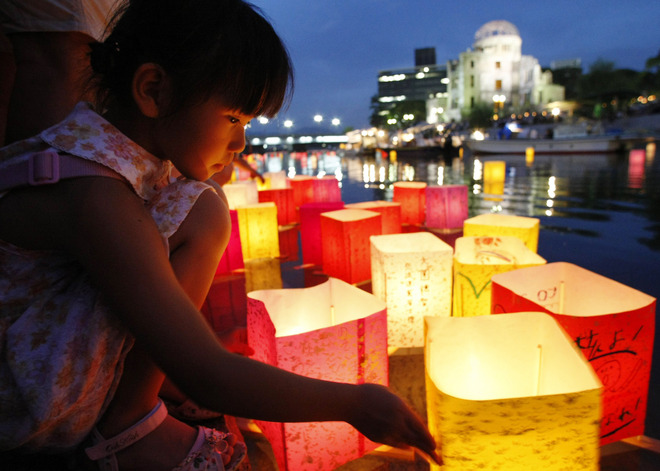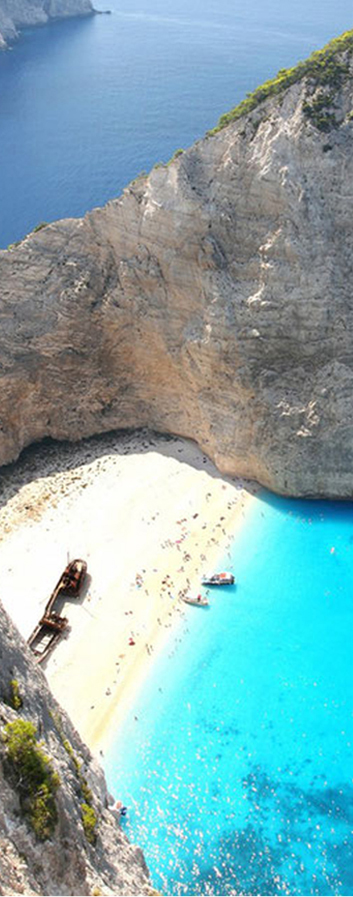A-bomb Dome
The A-Bomb Dome is the symbol of the "peace city", Hiroshima.
The A-Bomb Dome is a symbol of peace which most people have at least seen at one time in a picture. The building, which was designed by a Czech architect in 1915, had been used as the Hiroshima Prefectural Industrial Promotion Hall. Hiroshima citizens back then loved so much European modern-style buildings of the time. In 1912, the National Confectionery Exposition was held in this place. From that exposition, Baumkuchen, which represented German cake, was manufactured and sold in Japan for the first time. Since the Hiroshima Prefectural Industrial Promotion Hall was located only around 160 meters from the hypocenter, the building was blown up, and all those inside the building died. However, the building was not destroyed completely because the blast of the atomic bomb, which was vaporized in the air, prevented it from totally collapsing. It was designated a UNESCO World Heritage Site in 1996 and has been representing people's prayers for a lasting peace.
The Hiroshima Peace Memorial Park is located at the center of Hiroshima City, but remains a quiet and spacious place. It is difficult to imagine that this triangle shaped piece of land bordered by two rivers was once a busy commercial and residential downtown area. The atomic bomb eliminated everything in the town. After World War II, A group led by a Japanese architect named Kenzo Tange designed the park to turn the land into the Peace Memorial Park It was completed in 1954. There are many buildings and monuments which commemorate people who lost their lives at that time and also represent the people's prayers for peace, such as the Hiroshima Peace Memorial Museum, the Memorial Cenotaph and the Statue of the A-Bomb Children, etc. By imagining the contrast between the misery of the atomic bomb attack and the beauty and tranquility in the park while visiting spots in the park, we are moved to appreciate how precious peace is. The park is also known for its beautiful cherry blossoms. Over 300 cherry trees are found along the Motoyasu River which flows along the side of the park, many people visit to see cherry blossoms every spring. People enjoy river cruises on the Motoyasu River to see the park and the A-Bomb Dome from the river.

The Hiroshima Peace Memorial Park holds the Hiroshima Peace Memorial Ceremony on August 6th every year. Speeches by the Japanese Prime Minister, the Mayor of Hiroshima City, the representatives of local children are given, and then, a one-minute silence for the victims is observed at 8:15, the time of the explosion. Many people from all over the world attend the ceremony as well as pray in front of the Memorial Cenotaph and the Statue of the A-Bomb Children from early morning onward. In the evening, small lanterns are lit and floated downstream on the Motoyasu River alongside the park. The fire used for the lanterns is called the "Embers of the Atomic Bomb" which has been preserved by a person who experienced the bomb attack. Messages to console the souls of the dead and desire for peace are written on the lanterns. The view of hundreds of them flowing down the river is very mesmerizing. Recently we see many foreigners also participating in this event.

The Hiroshima Peace Memorial Museum is located in the Hiroshima Peace Memorial Park. By standing on the Peace Boulevard side, the Hiroshima Peace Memorial Museum, the Memorial Cenotaph, the Peace Flame and the A-Bomb Dome can be seen along a straight line. The Hiroshima Peace Memorial Museum, which opened in 1955, gives people an opportunity to learn of the outcome of the bomb attack and consider what peace really means through many reference materials. The East Wing exhibits photographs, panels, videos and panorama models showing the actual history of Hiroshima before and after the bomb attack. The main building exhibits victims' belongings and references which show the misery of the bomb attack. You will see a burnt lunch box, a tricycle which a 3-year-old boy was riding, etc., which reflect the instantaneous destruction and strike right at the heart of visitors. The Hiroshima Peace Memorial Museum was designed by a group headed by Kenzo Tange, who also designed the Hiroshima Peace Memorial Park. The strength of humanity rising up from the ruins is expressed in the piloti-style space under the main building. People visit the museum throughout the year and should be moved to a desire not to repeat the same misery anymore and consider deeply whether atomic weapons currently present are really necessary or not for our future.



































